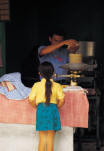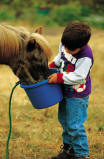What Learning Styles are Reinforced by
Homeschooling? Constructivist Approach: This view emphasizes the active role of the learner in building understanding and making sense of information. Student-Centered Instruction: The student actively assumes responsibility for his/her learning. Inquiry Learning: Students solve problems by
gathering data and testing their conclusions. Discovery Learning: Students are presented with examples and "discover" the underlying principles and rules. This is known as "inductive reasoning". This method also involves "intuitive thinking" (making imaginative leaps to correct perceptions or workable solutions.)
MotivationAnother wonderful feature of homeschooling is that the
student is much more apt to be "intrinsically
motivated" (whereby the activities and learning are
are their own reward). The source of motivation comes
from within ourselves. Intrinsic motivation leads to
true learning, critical thinking, and a lifelong love
of learning.
This is quite the opposite of much of classroom
instruction where motivation is often created by
external factors like rewards and punishments. In
this scenario, children are not really interested in
the activity for its own sake, but for what they will
gain from it.
Homeschooling gives you the power to individualize your child's education program. The majority of schools utilize the "one size fits all" approach. Unfortunately, this philosophy does not meet the educational nor emotional needs of many students. (An average class may have 30 students, all with varying skill levels, abilities, interests, learning styles, and emotional needs.)
As you listen to your child, you can assemble a program best-suited to meet your child's interests, skill levels, abilities, and learning style. When homeschooled students are accommodated for their different learning styles, they can learn in ways that reflect their particular strengths. For example, one student may want to build a bridge to learn and demonstrate knowledge about math and physics (not to mention art and history), while another student may want to write and perform a song about the Revolutionary War.
We know that some students are visual learners, some auditory, some kinesthetic. Homeschooling provides more opportunity for kinesthetic (or hands-on) instruction. This type of learning often provides more long-lasting knowledge retention, not to mention that the process is usually more fun! For example, a student may want to build a model of an Egyptian pyramid using sugar cubes, instead of solely reading about pyramids.
Furthermore, in addition to hands-on activities, homeschooling often provides many opportunities for functional practice (real-life applications). When practice is relevant, students can easily see the connection between what they are learning and its use in real life. (A common classroom refrain heard by
the teacher is, "Why should I do this; when am I ever going to have to use this in real life?") Additionally, children's success in functional activities can be used to predict their success in adult life. 
Suggestions for Real-Life Activities - Reading and writing directions
- Making and reading maps
Creating and reading a menu Reading food labels (nutrition/math) Reading medicine labels, clothing labels Reading the telephone book/yellow pages Reading catalogs and advertisements Reading schedules (e.g.: train, television) Reading signs Reading newspapers, magazines Using the Internet Writing a letter, a message, a postcard Writing a shopping list Completing a job application Completing a library card application Filling out an order form Writing a telephone message Making change Counting money Buying something in a store Using a credit card Using a check and balancing the account Making a budget Telling and estimating time Reading a calendar Reading a thermometer Measuring objects and distances Determining weight and height
Multiple Intelligences Theory
Educational psychologist Howard Gardner's theory of Multiple Intelligences suggests that there are seven separate intelligences or abilities. Homeschoolers are often more easily able to have these seven intelligences addressed, and to have their educational programs tailored to match their particular strengths. Gardner's Multiple Intelligences - logical-mathematical
- linguistic
- musical
- spatial
- bodily-kinesthetic
- interpersonal
- intrapersonal
The seven intelligences Gardner defines are: - Logical-Mathematical - Consisting of the ability to detect patterns, reason deductively and think logically.
Linguistic - Involves a mastery of language. Spatial - Gives one the ability to manipulate and create mental images in order to solve problems. Musical - Capability to recognize and compose musical pitches, tones, and rhythms. Bodily-Kinesthetic - Ability to use one's mental abilities to coordinate one's own bodily movements. The Personal Intelligences--includes interpersonal feelings and intentions of others--and intrapersonal intelligence--the ability to understand one's own feelings and motivations.  | | Humanistic theorist, Abraham Maslow, studied the role of needs in determining motivation. In his Hierarchy of Needs Model, the four lower level needs (Deficiency Needs) must be satisfied first before the motivation to achieve higher needs can occur. In a homeschooling situation, it is often much easier for a child to have these lower level needs met.- Physiological Needs: sleep, thirst, hunger
- Safety Needs: freedom from danger, anxiety, and
threat to psychological well-being - Love Needs: acceptance from parents, teachers,
peers, and significant others - Esteem Needs: self-efficacy, competency, belief in
one's abilities often validated by others - Intellectual Achievement Needs: need to understand
and grow intellectually - Aesthetic Needs: appreciation for beauty, culture,
literature, music, the arts - Needs for Self-Actualization: attempt to realize
personal potential, striving to become the best that
you can be
Piaget's theory of cognitive development is applicable when considering age and stage appropriate curriculum and teaching techniques. According to Piaget, there are four stages of cognitive development. - The first stage is infancy: the Sensorimotor Stage, approximately birth - two years old. In this stage, object permanence, sensorimotor schemes, and goal-oriented behaviors are important.
- The second stage is early childhood to early elementary: Preoperational, approximately two - seven years old. In this stage, semiotic function (using language, pictures, etc. to represent objects or actions), collective monologue, and operations are important. Children at this stage are very egocentric.
- The third stage is the later elementary to middle school years: The Concrete Operational Stage, approximately seven - eleven years old. In this stage concrete operations are important. Additional teaching techniques such as conservation, decentering, the consideration of identity, compensation, classification, and seriating can now be employed.
- The fourth stage is the junior and senior high stage: Formal Operations, approximately 12 years old -adulthood. Abstract thinking, hypothetic-deductive reasoning, and adolescent egocentrism are all featured during this stage.
 Bloom's Taxonomy Educational theorist, Benjamin Bloom, led some important studies regarding educational objectives. His work is useful in planning assessments. His examination of the cognitive domain (that involving memory and reasoning objectives) resulted in "Bloom's Taxonomy" (a classification system). Bloom's Taxonomy From lowest to highest objectives: - Knowledge: remembering, recognizing without necessarily understanding, using or changing it
- Comprehension: understanding the material without necessarily relating it to anything else
- Application: using a general concept to solve a particular problem
- Analysis: breaking something down into its parts
- Synthesis: creating something new by combining different ideas
- Evaluation: judging the value of materials or methods as they might be
|
|

